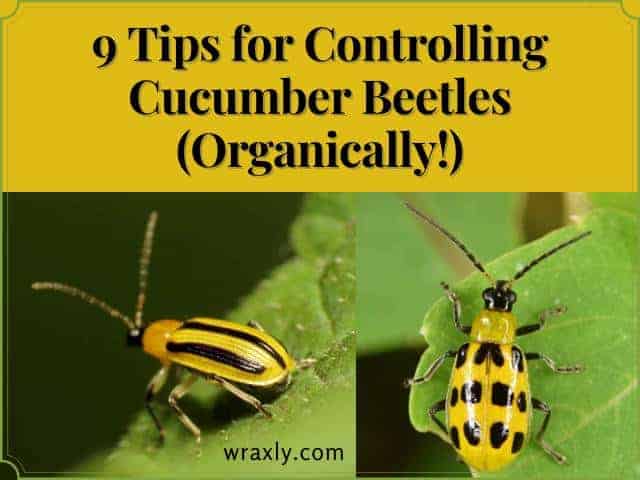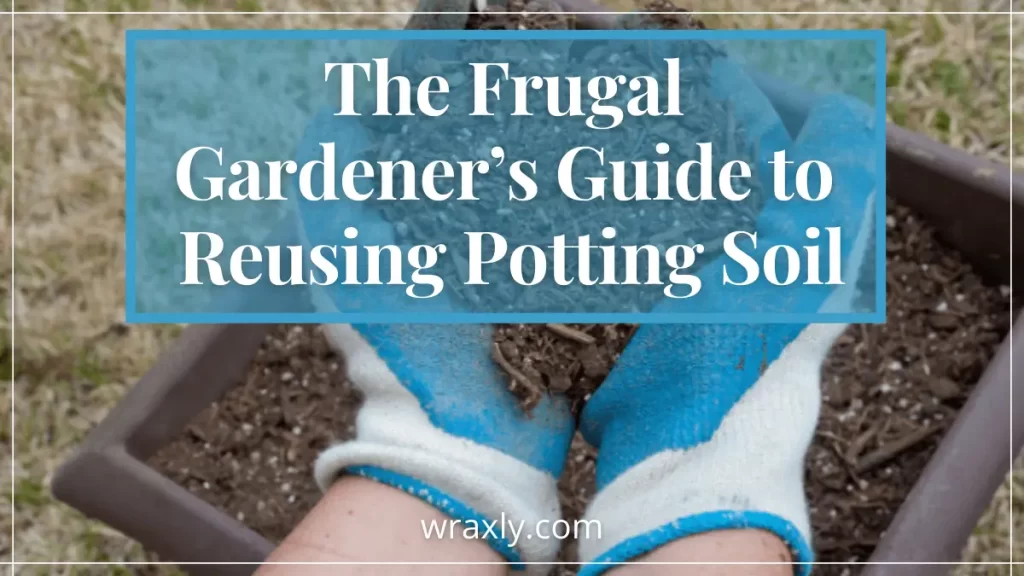Cucumber beetle infestations are not only a nuisance. They can also do severe damage by chewing the leaves and flowers of your crops and inducing bacterial wilt. Fortunately, there are several ways in which you can go about controlling cucumber beetles organically. This article will introduce you to nine of the most effective ones.

- 1) Know Which Plants are at Risk of Cucumber Beetle Infestation
- 2) Understand the Two Main Types of Cucumber Beetle
- 3) Choose Appropriate Companion Plants
- 4) Allow other Insects to Live in Your Garden
- 5) Inspect Your Plants for Cucumber Beetles Regularly
- 6) Keep Planting Areas Clean and Debris-Free
- 7) Protect Your Plants with Row Covers
- 8) Plant a Trap Plant for New Cucumber Beetles
- 9) Rotate Your Cucurbit Crops
- Controlling Cucumber Beetles Organically – FAQs
- Final Thoughts on Controlling Cucumber Beetles Organically
1) Know Which Plants are at Risk of Cucumber Beetle Infestation
Mitigating the harmful effect of cucumber beetle infestations begins with identifying which of your plants are most at risk. Typically, the plants cucumber beetles afflict most often belong to the Cucurbitaceae family, members of which we sometimes call cucurbits. Here are a few examples of popular crops in that group:
- Cucumbers
- Melons
- Pumpkins
- Squashes
- Zucchini
Other plants outside of the cucurbits attract cucumber beetles as well, especially species that flower early in the spring. Knowing which of your plants is at risk of damage from cucumber beetles is an excellent start. However, you’ll need plenty more insights before you can control cucumber beetles.
2) Understand the Two Main Types of Cucumber Beetle
Not all cucumber beetles are alike. In fact, there are two main groups of cucumber beetles that you should know the difference between:
- Spotted cucumber beetles (Diabrotica undecimpunctata)
- Striped cucumber beetles (Acalymma vittatum)
Although these two beetles are quite similar, there are some key distinctions worth mentioning. As you would expect, spotted cucumber beetles and striped cucumber beetles have differences in appearance. Both are about one-fifth of an inch long and have yellow wings with black markings. The name of each beetle indicates how those black marks appear.
The two types of cucumber beetle also have different behavioral tendencies. For example, striped cucumber beetles tend to feed on cucurbit crops, while spotted cucumber beetles affect a broader range of plants from multiple plant families. As such, when you understand the two main types of cucumber beetles and how to identify them, you’ll have a better idea of which plants you’ll need to protect.
Click here to download your FREE guide to organic weed and pest control
3) Choose Appropriate Companion Plants
One of the best ways to prevent cucumber beetles from arriving in your garden is to grow plant species that deter them. Here are some of the best companion plants for cucurbits to keep cucumber beetles away:
- Asters
- Catnip
- Corn
- Marigold
- Radishes
- Tansy
There are two primary ways that plants can help ward off cucumber beetle infestations. While some plants repel cucumber beetles, others attract the cucumber beetle’s natural predators. Either way, planting some of the species from the list above is a fantastic way to discourage cucumber beetles from entering your garden.
4) Allow other Insects to Live in Your Garden
This tip may seem somewhat counterintuitive to a beginner gardener hoping to prevent insect infestations in their garden. However, allowing certain insects to live near your plants is exceptionally beneficial when you want to prevent cucumber beetles from taking over. Here are a few examples:
- Braconid wasps
- Ground beetles
- Ladybugs
- Soldier beetles
- Wolf spiders
Cucumber beetles are large compared to many other insects. They also have durable outer shells that make it difficult to eat them. Thankfully, the critters on the list above are all capable of preying on cucumber bugs. To leverage this preventative strategy, all you need to do is grow plants that cucumber beetle predators enjoy.
5) Inspect Your Plants for Cucumber Beetles Regularly
Inspection is another regular maintenance task that you can take up to monitor any potential cucumber beetles in your garden. If you grow plants that are susceptible to these pests, inspect them closely throughout the entire growing season.
When inspecting your garden, look for adult cucumber beetles and cucumber beetle eggs. Recall that adult cucumber beetles are just a fraction of an inch long and have a primarily yellow appearance. They will also have either black dots or black stripes, depending on the variety.
Cucumber beetles typically lay their eggs at the base of plants near the surface of the soil. The eggs are small but tend to accumulate in visible masses.
As soon as you notice adult cucumber beetles or their eggs on your plant, it is time to begin removing them. The sooner you notice and address the presence of cucumber beetles, the greater your chances are of getting rid of them, which is why regular inspection is so crucial.
6) Keep Planting Areas Clean and Debris-Free
Cleaning any planting beds that contain cucurbit plants is essential when controlling cucumber beetles organically. Cucumber beetles typically use dead leaves and other types of plant debris to overwinter. The coverage of those materials allows cucumber beetles to remain safe and warm during the coldest months of the year.
If you allow plant debris to pile up in your garden beds and leave it over the winter, you may experience a cucumber beetle infestation during the following growing season. While cleaning up garden debris alone is not enough to deter these pests, it is a necessary measure.
Clean your garden beds throughout the growing season to prevent cucumber beetles from using them as a form of shelter. Then, perform a thorough cleaning just before the winter arrives to remove what would be a seasonal home for cucumber beetles
You may also be interested in… Chiggers vs Clover Mites: How to tell the difference
7) Protect Your Plants with Row Covers
One of the surest ways to establish a barrier between your plants and a group of cucumber beetles is to use floating row covers. Floating row covers consist of woven plastic, polyester, or other synthetic materials.
Row covers come in a few different varieties, each of which can offer one or more benefits for your crops. For instance, while some row covers do nothing more than prevent pest infestations, others can provide wind protection and warmth during cold weather.
Installing a row cover is typically an easy process. All you need to do is lay one over your newly planted crops. Ensure that the edges of the cover are sunk into the ground to create a complete seal without any gaps a bug could crawl through. However, you’ll also need to keep the cover loose enough to allow your plants to grow within it.
While row covers are not the most attractive addition to a garden, they have an immense practical use for pest prevention. Few other methods will be as effective for keeping cucumber beetles out of your crop rows.
Learn more about organic pest control
8) Plant a Trap Plant for New Cucumber Beetles
Among the more interesting tactics for controlling cucumber beetles is the trap plant method. This approach involves growing a plant species that cucumber beetles feed on at the edge of your garden. Any cucumber beetles in the surrounding area will likely arrive at that plant. You’ll want to allow cucumber beetles to accumulate at your trap plant then use an insecticide to kill them.
This method is best for preventing new cucumber beetle infestations from taking place. By attracting these insects to a known location, you can anticipate their arrival and eliminate them before they have a chance to spread throughout the rest of your garden.
9) Rotate Your Cucurbit Crops
Crop rotation is vital for preventing cucumber beetles. The reason for this is that cucumber beetles can live on the remains of last season’s cucurbit crops. If you choose to grow similar crops in the same location during the following season, an infestation can occur.
During your fall clean-up, you should focus on removing all plant debris from the area. However, even if you do a thorough cleaning job, the remains of your crops can still help cucumber beetles survive the winter, which is why you should avoid planting the same cucurbit plants in the same bed season after season.
FOR FURTHER READING
- Do Spider Mites Live in Soil?
- Chiggers vs. Clover Mites
- How To Get Rid of Clover Mites
- How To Get Rid of Gnats in a Vegetable Garden
Controlling Cucumber Beetles Organically – FAQs
Now that you know some of the ways that you can prevent and control cucumber beetles let’s address some of the most common questions people have about these garden pests.
It will be difficult to notice cucumber beetles on your plants if you conduct your inspections when these insects are not active. Generally, cucumber beetles are most active during daytime hours between dawn and dusk. That activity makes it relatively easy to spot these bugs if they are present in your garden.
A single adult female cucumber beetle can lay around 800 eggs at one time. That copious number of eggs is what makes cucumber beetle infestations so pervasive. Each egg can hatch in just over one week, and in just ten more days, the cucumber beetle hatchings will become adults.
Most insecticide soaps will work well to kill cucumber beetles. The best way to make these products work well is to apply them where you know cucumber beetles tend to congregate. Apply insecticide soaps to the undersides of leaves and at the base of your plants where cucumber beetles lay their eggs.
Final Thoughts on Controlling Cucumber Beetles Organically
Cucumber beetles are an unfortunate sight in your garden, but it is entirely possible to control them. If you have a problem with cucumber beetles, or you want to prevent an infestation from occurring in the first place, the tips in the list above will serve you well.

John Haryasz is a freelance writer and landscape designer. In the field of landscape architecture, he has contributed to many successful design projects throughout the country. As a writer, John specializes in creating captivating and informative web content. Through that work, he aims to share his design knowledge and promote engagement with the outdoor world.



![10 Common Container Garden Mistakes to Avoid [Beginner’s Guide]](https://wraxly.com/wp-content/uploads/2021/02/10-Common-Container-Garden-Mistakes-to-Avoid-Beginners-Guide-1200-1024x576.webp)